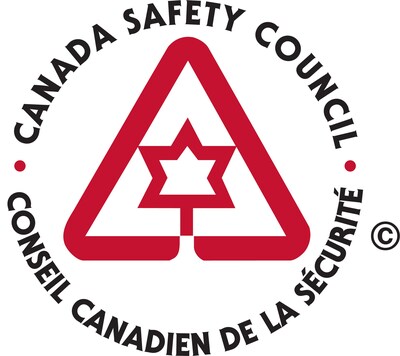OTTAWA,
ON, July 30, 2024 /CNW/ - The Canada Safety
Council is urging all Canadians to be aware of the signs of an
accidental opioid overdose, their role in helping manage the
crisis, and what to do in case of emergency.
"The opioid crisis in Canada is
a public health emergency that affects us all, claiming lives and
devastating communities," said Gareth
Jones, President and CEO of the Canada Safety Council. "We
urge everyone to recognize the profound impact of this crisis on
individuals and families, prioritizing education, support, and
access to treatment to prevent further loss and ensuring a safer,
healthier future for all Canadians."
The Issue
The impact of the opioid crisis in Canada have been well documented and cannot be
overstated. Between January 2016 to
December 2023, there was more than
44,000 apparent opioid toxicity deaths, and more than 42,000 people
were hospitalized for a reported opioid-related poisoning with 65%
reported as accidental.1
Signs & Symptoms of an Accidental Opioid Poisoning:
2
- Blue or grey lips or nails
- Very small (pinpoint) pupils
- Cold and clammy skin
- Dizziness and confusion
- Extreme drowsiness
- Choking, gurgling or snoring sounds
- Slow, weak or no breathing
- Inability to wake up, even when shaken or shouted at
Please note as opioids can affect individuals differently, not
all signs listed above may be visible in every case.
How to Respond 2
Opioids affect the part of your brain that controls your
breathing. When you take more opioids than your body can handle
(overdose), your breathing slows. This can lead to unconsciousness
and even death without appropriate intervention. An opioid overdose
is always an emergency.2
If you believe someone is suffering from an opioid overdose,
check for response by speaking loudly and rubbing a fist on the
middle of the suspected poisoning victim's chest. If there is no
response, call 9-1-1 right away, or your local emergency help
line.
Give the person naloxone if it's available. Naloxone is a
medication that can help temporarily reverse an overdose if it is
administered right away. You can give naloxone while you wait for
professional help to arrive.3
Even if someone has taken naloxone, it can wear off before the
person has completely recovered from their overdose. They may need
additional dose of naloxone after two to three
minutes.3
Always call for help and follow the directions in your naloxone
kit and from the 9-1-1 or emergency help line operator.
Under the Government of Canada's Good Samaritan Drug Overdose Act, you
may be afforded some legal protection from prosecution under
certain controlled substance possession laws. Click here for more
information 4
Naloxone
Naloxone is a fast-acting drug designed to temporarily reverse
the effects of an opioid overdose by blocking opioid receptors in
the brain.3 It is non-addictive, safe to use, and is a
vital tool in the fight against accidental opioid
poisonings. 5 Concurrently, the Canada Safety
Council believes you should always have it on hand — as
established, speed in treatment is of the essence.
Naloxone is available in two formats, an injectable naloxone or
naloxone nasal spray, also known by the brand name
NARCAN® Nasal Spray.3 In certain provinces
and territories, NARCAN® Nasal Spray may be accessed at
no cost to all residents, through their take-home naloxone (or
equivalent) programs. NARCAN® Nasal Spray can also be
ordered online at OrderNARCAN.ca, in those provinces and
territories that do not include NARCAN® Nasal Spray on
their take-home naloxone programs (or equivalent).6
A prescription is not required.3 In some provinces,
there is a legislative requirement for some employers to ensure
that a naloxone kit is made available. 7,8,9 Check
the requirements for your province.
Responsibility
Opioid poisonings occur frequently across Canada, as evidenced by the
statistics.1 They may occur at home, in the workplace,
in public and private spaces.10
We all have a role to play.
Be sure to keep naloxone, like NARCAN® Nasal Spray,
on hand. It is an important tool that can only be put into use if
it is available. Fighting the opioid crisis can only be done when
everyone is doing their part to help and is prepared to respond
quickly, decisively, and with knowledge of how to handle the
situation.
Be informed, be prepared, and you too may help save lives.
References:
|
1 Federal, provincial, and
territorial Special Advisory Committee on the Epidemic of Opioid
Overdoses. Opioid- and Stimulant-related Harms in Canada. Ottawa:
Public Health Agency of Canada; June 2024,
https://health-infobase.canada.ca/substance-related-harms/opioids-stimulants/.
Accessed July 19, 2024
|
|
2 Health Canada. Opioid Overdose.
April 2024,
https://www.canada.ca/en/health-canada/services/opioids/overdose.html#a3.
Accessed July 19, 2024.
|
|
3 Health Canada. Naloxone. April
2024,
https://www.canada.ca/en/health-canada/services/opioids/naloxone.html#1.
Accessed July 19, 2024.
|
|
4 Health Canada. About the Good
Samaritan Drug Overdose Act. November 2021,
https://www.canada.ca/en/health-canada/services/opioids/about-good-samaritan-drug-overdose-act.html.
Accessed July 19, 2024.
|
|
5 Opioid Overdose Basics:
Understanding Naloxone. National Harm Reduction Coalition.
September 8, 2020,
https://harmreduction.org/issues/overdose-prevention/overview/overdose-basics/understanding-naloxone/.
Accessed July 19, 2024.
|
|
6 How
Can You Get NARCAN® Nasal Spray? March 2024,
https://narcannasalspray.ca/en/#how-can-you-get-narcan. Accessed
July 19, 2024.
|
|
7 Ministry of Labour,
Immigration, Training and Skills Development. Occupational health
and safety act, R.S.O. 1990, C. O.1. April 2024,
https://www.ontario.ca/laws/statute/90o01#BK49. Accessed July 19,
2024.
|
|
8 Ministry of Labour,
Immigration, Training and Skills Development. Naloxone in the
workplace. April 2024,
https://www.ontario.ca/page/naloxone-workplace. Accessed July 19,
2024.
|
|
9 Government of Alberta:
Ministry of Mental Health and Addiction. Workers administering
injectable naloxone. 2024,
https://www.alberta.ca/workers-administering-injectable-naloxone.
Accessed July 19, 2024.
|
|
10 Ontario
Drug Policy Research Network; Office of the Chief Coroner for
Ontario/Ontario Forensic Pathology Service; Ontario Agency for
Health Protection and Promotion (Public Health Ontario); Centre on
Drug Policy Evaluation. Preliminary Patterns in Circumstances
Surrounding Opioid-Related Deaths in Ontario during the COVID-19
Pandemic. Toronto, ON: Ontario Drug Policy Research Network; 2020.
https://www.publichealthontario.ca/-/media/documents/o/2020/opioid-mortality-covid-surveillance-report.pdf?la=en.
Accessed July 19, 2024.
|

SOURCE Canada Safety Council